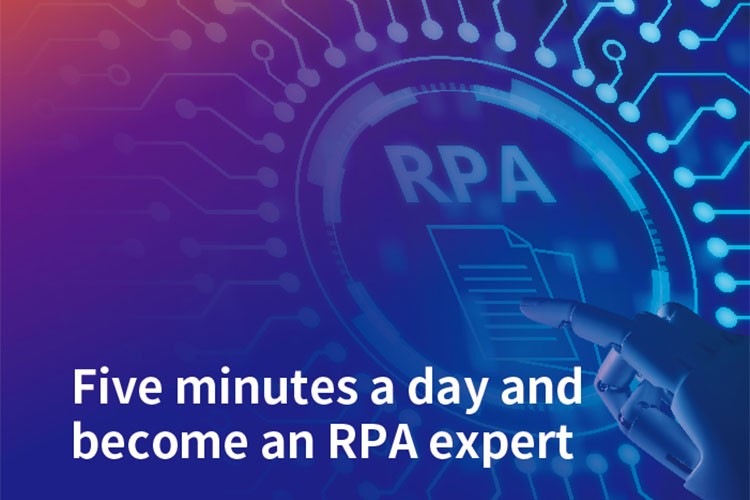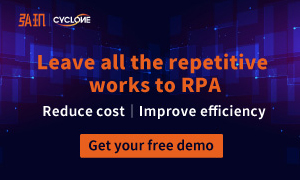1. What is RPA?
RPA is the acronym for Robotic Process Automation. Let's look into these words:
• Robots (also called RPA robots) are entities simulating human behaviors like clicking and opening applications, processing Excel spreadsheets and logging into business systems, etc.
• Process refers to several steps to complete a meaningful activity, such as logging into SAP to downloading a report, logging into OA to download an attendance table in Excel for calculating employees' salaries.
• Automation refers to the business processes executed by robots without human intervention.
In summary, RPA (Robotic Process Automation), as the core infrastructure in an enterprise's business automation, can simulate human interactions with software to automate those rule-based and repetitive business processes to enhance productivity and reduce labor costs.
2. Evolution of RPA
Although RPA was accepted as the preferred optimization solution 100+ years after the first automatic production line emerged globally, RPA has gone through four stages in as short as 20 years since the first professional RPA tool was rolled out.
1. RPA 1.0: Attended RPA
During this stage, RPA, as Virtual Assistant, incorporated nearly all major functions of robotic automation and all features of existing desktop automation software. It was deployed on employees’ PCs to increase their productivity. However, it’s hard to achieve end-to-end automation, and broader deployment is not possible. Despite these weaknesses, attended RPA can reduce the average time spent on the business processes, improve customers’ experience and save costs.
2. RPA 2.0: Unattended RPA
During this stage, RPA is known as Virtual Workforce. It aimed to achieve end-to-end automation and virtual labor tiering. It was deployed mainly on VMS virtual machines, orchestrating daily work, centralizing robot management and analyzing robot performance, etc. But the RPA software robot still required human intervention and control. The Unattended RPA robot can work 24/7 around the clock. Business processes were used in place of human-machine interactions, bringing more possibilities to increase efficiency and cut costs.
3. RPA 3.0: Autonomous RPA
During this stage, RPA intended to realize the end-to-end automation and multiple-purpose virtual workforce with a larger size. It was typically deployed on cloud servers and SaaS, featuring automated tiering, dynamic load balancing, contextual awareness, advanced analytics, and workflow. And its weakness is still the insufficient capacity to handle the unstructured data. However, thanks to the integration of more technologies, it could increase the business value and bring more benefits to users.
4. RPA 4.0: Cognitive RPA
In RPA 4.0, we could see the future RPA. It has adopted advanced technologies like AI, machine learning, and natural language processing to handle the unstructured data, analyze the predictive specifications and automate task acceptance. With the Cognitive RPA, robots can work by themselves to make decisions, thus automating all complex and lengthy tasks.
At present, most RPA software products are at the stage between 2.0-3.0, but they have already been mature and increasingly put into production. In addition, some leaders in this industry have set out to explore RPA 4.0, and started to use AI to enhance the cognitive capability of RPA products.
3. What does RPA do?
RPA is a computer program that can handle repetitive tasks and simulate manual operations. It can help perform many daily operations, including but not limited to:
1. Data Search
The RPA robot can automatically access your intranet and extranet, capture page elements flexibly, search for data by keywords, and extract and store relevant information, according to the preset rules.
2. Data Migration
Featuring flexible scalability and non-intrusion, RPA can be integrated into multiple systems, handle the structured data across systems automatically, migrate data, and verify data for integrity and accuracy without disrupting the existing system structure.
3. Data Entry
RPA can recognize the data on any paper materials with OCR technology and automatically input the captured data into the system for archiving.
4. OCR Recognition
The RPA robot can further optimize, adjust and classify the data on the scanned image via OCR, extract information from key fields, and convert them into structured data.
5. Information Review
The RPA robot can simulate the human operations according to the preset rules and review and preprocess the textual information on the OCR recognized image, converting the scanned image into information.
6. Uploading/downloading
Data and information in files often need to be transferred across systems and platforms. The RPA robot can simulate the human operations to automatically log into multiple heterogeneous systems to upload the specified data and information in files to specific systems. It can also download such data and information from those systems, store them in the preset paths, re-upload them to relevant platforms, or perform other actions according to the rules.
7. Filtering/Summarizing
The RPA robot can automatically filter the raw structured data based on the preset rules, then summarize and reorganize the filtered data to get the relevant data that matters in the individual management processes.
8. Reorganizing/validating
The RPA robot can transform and reorganize the extracted structured and non-structured data, then output them based on standard template files. In this way, it can realize the full automation from data collection to data reorganizing and outputting. And RPA can also automatically validate the data, identify and analyze the data errors.
9. Reports Generation
RPA can put the data obtained from internal and external sources together in an orderly way according to the preset rules, then automatically generate reports based on the standard templates.
10. Pushing Notifications
In handling a task, RPA can automatically push the key information identified to the relevant persons under the task node to let them know about it promptly and drive the business process forward.
4. What are the features of RPA?
RPA is primarily designed to replace repetitive human work, and reduce human errors. In general, RPA has features as below:
1. Faster Speed
RPA can perform repetitive tasks as per clear business rules. It runs faster than humans, thus leading to quicker responses and more tasks handled.
2. Lower Costs
The RPA robot can work 24/7 around the clock without errors, thus saving labor and time for a company.
3. Lower Barriers to Entry
No programming knowledge is required. The business personnel can skillfully use the RPA robot only through a short period of learning. After receiving special training for some time, they can even design their RPA processes, saving them more time to take more valuable creative work.
4. No Disruption to Existing Systems
The RPA robot mainly simulates the user’s actions on the front-end interface based on the screen capture technology. You don’t have to reconstruct existing systems to quickly meet the new business requirements, thus reducing the complexity and risks in IT deployment.
5. High Scalability
The RPA robot can be deployed on physical and virtual machines. Cyclone’s robots can also be deployed and run in different systems and environments like Windows systems, Mac systems, Linux systems, China’s domestic systems, and mobile devices. The enterprise can expand business scenarios and the number of robots whenever required.
6. Safety and Compliance
RPA performs tasks based on clear business rules, which allows it to handle the businesses more accurately, and in strict compliance with policies, thus eliminating human errors. Users can review and track RPA operations by using logs, screenshots, and video clips.
For more information about digital transformation, please click here.
iBPMS at a glance: click iBPMS.





